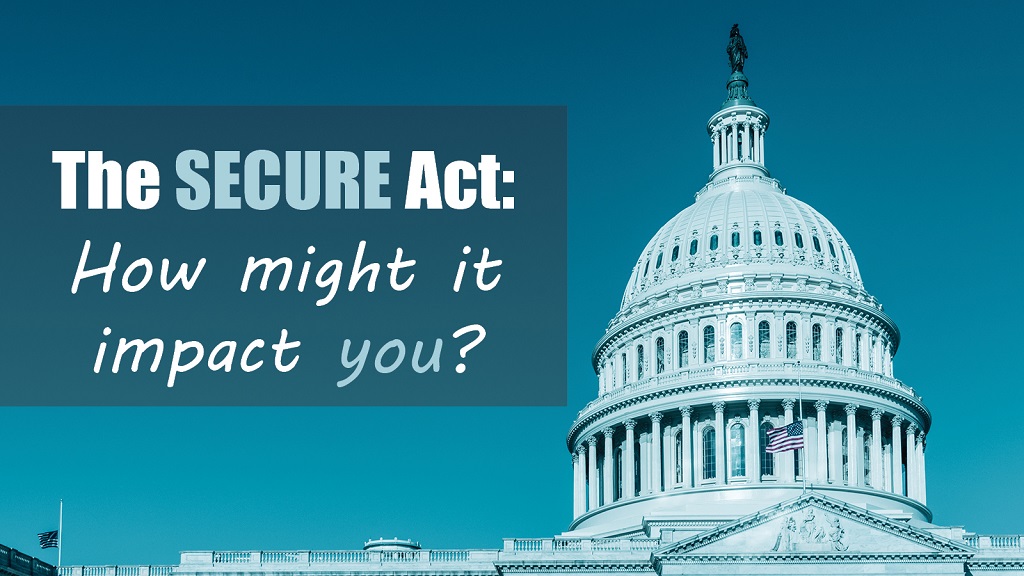The SECURE Act: How might it impact you?

The Secure Act has nearly 30 new provisions in it. Many of you have probably heard or read about it lately and I want to highlight a few key areas that may impact you. For the sake of brevity, I’m going to simplify many of the concepts. My hope is that as you read this, you may think of questions to ask your attorney, accountant, and/or advisor.
- Required Minimum Distribution Age Increased to 72 – Many people are familiar with the fact that the IRS requires individuals to eventually take distributions from certain qualified retirement accounts. Distributions were required to begin April 1st in the year after the individual reached age 70.5; however, the SECURE Act increased the required minimum distribution age to 72. This is good news for individuals who turn 70.5 after 12/31/2019. The old rules still apply to individuals who reached age 70.5 prior to 12/31/2019.
- Eligible Retirement Contribution Age Removed – Previously, individuals were prohibited from making Individual Retirement Account contributions if they were over 70.5 and still working. Now, if individuals have earned income, they can make contributions to an IRA.
- Qualified Charitable Distribution (QCD) Age Remains 70.5 – The age at which individuals are eligible to make qualified charitable distributions is still 70.5. This isn’t a change, but something that is important to note because previously this age coincided with an individual’s required minimum distribution age. A very important point is that to be treated as a QCD, the individual must be over 70.5 on the day of the distribution, not just the year in which they turn 70.5. If the QCD occurs when the individual is 70.49, they’re out of luck. There are some anti-abuse rules that relate to QCDs and retirement contributions made after the individual turns 70.5. I’ll spare you the details, but if you find yourself in this situation, it’s worth talking with your advisor.
- Elimination (mostly) of the “Stretch” IRA Provision – Previously, some non-spousal beneficiaries of retirement accounts were allowed to “stretch” their required minimum distributions out over their lifetimes. The SECURE Act effectively eliminated most situations where a “stretch” could be used and replaced it with a requirement for the beneficiary to distribute all the funds in the account by the end of the 10th year (the 10-year rule). Individuals who inherited retirement accounts prior to 12/31/2019 are grandfathered in under the previous rules. There are still situations where the stretch is available (spouses, minors, or people with disabilities, et al.), so check with your advisor if you have questions.
- Estate Planning with IRAs and Trusts – This point is related to the stretch provision, but I felt like it deserved its own bullet point because of its importance. If you have named a trust as your beneficiary (primary or contingent) on any retirement account, please speak with your attorney, accountant, or advisor. The 10-year rule can cause some negative, unintended consequences depending on the language included in the will or trust. I often see this type of arrangement with younger professional families that have a sizeable amount of retirement assets that they may not want their minor children to have access to prior to certain ages.
- 529 Plans – Up to $10,000 from 529 plans may be used to pay off student loan debt of the 529 beneficiary and the beneficiary’s siblings. The $10,000 is a lifetime limit per individual and also applies to the costs of an apprenticeship program.
- Employer Retirement Plan Tax Credits – The SECURE Act sweetened the pot for small business owners to start retirement plans. Subject to certain conditions, employers can receive up to a $5,000 tax credit related to start-up costs for 401(k)s, 403(b)s, SEP IRAs, or Simple IRAs. There is also a separate $500 credit available for three years for plans that adopt auto-enrollment for their participants.
There are many more changes associated with the SECURE Act that may impact your individual situation. In the Financial Planning Department, we’re fond of saying that the answer to every planning question is, “It depends.” I hope that after reading this article, you understand some of the bigger changes associated with the SECURE Act and will reach out to your advisors with questions.


